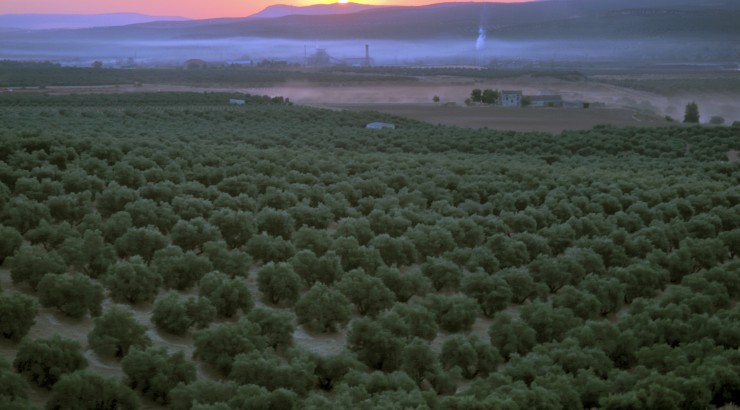
My Work at Ancient Cástulo
August 20, 2014
This is the third post in a series on my work at ancient Cástulo, in southeastern Spain. (Read my other entries: Faculty Research in Ancient Castulo and Interactions with the Ancient World). In this one, I thought I would describe an average day in the life of an excavation like the one at Cástulo.
When I tell people I’m an archaeologist, Indiana Jones almost inevitably forms part of the response. While this is understandable (most of us love those movies, too — except for the fourth one, which, as a colleague here said the other day, “That one never happened!”), there’s really no connection between anything found in those films and our experience on-site. Here is a sample of what we do.
5:45 a.m.: Wake up, quick Skype chat home (9 hours time difference, so it’s 8:45 p.m. in Los Angeles) to catch up on the day’s news, breakfast, figure out which of already-dirty work clothes can take another day, glance at news websites.
6:50 a.m.: Catch a ride to the site with one of the other archaeologists (car might have as many as six other human occupants and a dog, as well as some of our more expensive equipment, like a total station ($$$) for surveying X/Y/Z coordinates on-site).

7:10 a.m.: Arrive at site. The sun still has not risen, since Spain is so far west in its time zone — we are working as early as possible to avoid the heat, which has already reached 42 C (108 F) this season. Occasionally, other groups of people are also arriving, such as local falconers out to hunt the rabbits which are so abundant in the area. One morning, we met some of these hunters with their falcons; I was able to snap a quick shot of FORVM MMX archaeologist Maica Cortés López holding one of the birds.
Once we arrive, we gather equipment from the storage containers that were set up near the primary area of excavation. These containers were decorated two years ago by
Belin, a world-famous street artist
from Linares —
on one side a youth from Linares with a sculpture of a sphinx (found at the site) superimposed over his face, on the other a depiction of a coin from Cástulo
.
7:20 a.m.: Work begins. Hired workmen begin to break up soil in areas which remain to be excavated; archaeologists work the sifters to identify objects in the soil, such as pottery, bone, coins, glass, and mosaic tiles; and supervisors monitor the activity and record notes and data. Sometimes objects appear even before sifting.
I found a large piece of Roman-period glass from a plate within 15 seconds of jumping into a trench at Cástulo!
Check out other pieces of glass from the same trench.

Loli, one of the workmen, consults with archaeologist Yolanda about what he’s finding in the cistern.
One way to illustrate how the group works is to describe a particularly interesting discovery of a Roman Imperial cistern that we made in my second week on-site. I can actually claim to be the discoverer, even though I didn’t realize it at the time — I was cleaning the trench for photographs and by chance opened a small hole, about six inches in diameter. It’s very unusual to find a hole in a trench, since the soil is usually packed tight and there are no voids. Because the hole was small, I thought perhaps it was an animal hole of some kind. It was only a few days later, when the stones over the hole were removed, that we learned that there was actually a cistern for storing water. We now believe that it is anywhere from 2-6 meters (6.5-20 feet) deep — the only way to find out is to remove the soil that has accumulated inside. One of the workmen and several archaeologists have taken turns inside the cistern to begin removing soil. It’s dirty work –
whoever’s in there gets covered head-to-toe
.
10 a.m.: Breakfast break. The whole team gathers at the storage unit for a half-hour break to eat and chat. Capi, the team mascot, begs for food from everyone, and usually gets something. Capi was adopted last year by one of the team members who found him roaming the site. He comes to work every day and goes from trench to trench checking on everyone.
10:30-2 p.m.: Back to work/more of the same.
While all of this activity is happening on-site, more archaeologists, IT professionals, and conservators are working back at the Cástulo museum in Linares on the objects that have been recovered. On Mondays at 5 p.m., the group meets back at the dig house, where many of the archaeologists live, for a meeting to discuss major problems such as the interpretation of a building in one of the trenches. Otherwise, from 2 p.m. to 5 p.m. is lunch siesta. In the evenings, the archaeologists responsible for trenches work on their notes and double-check that finds have been recorded correctly in the database. Then it’s time for much-needed sleep before another day begins.
Next time: Special experiences at Cástulo, including a flight in a two-seater plane over the site!
Ancient Cástulo Part One
|
Ancient Cástulo Part Two
|
Ancient Cástulo Part Four
|
Ancient Cástulo Part Five








